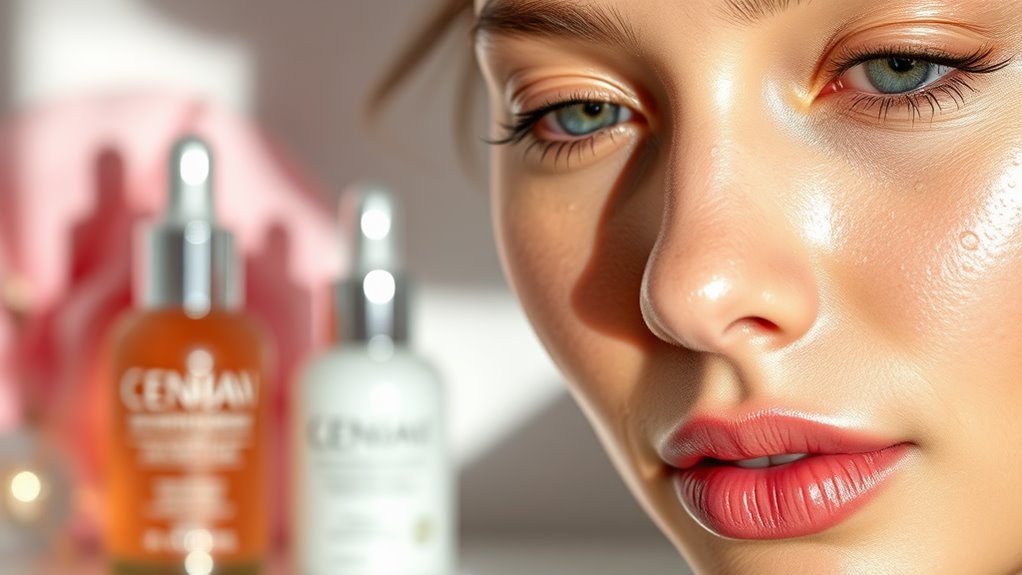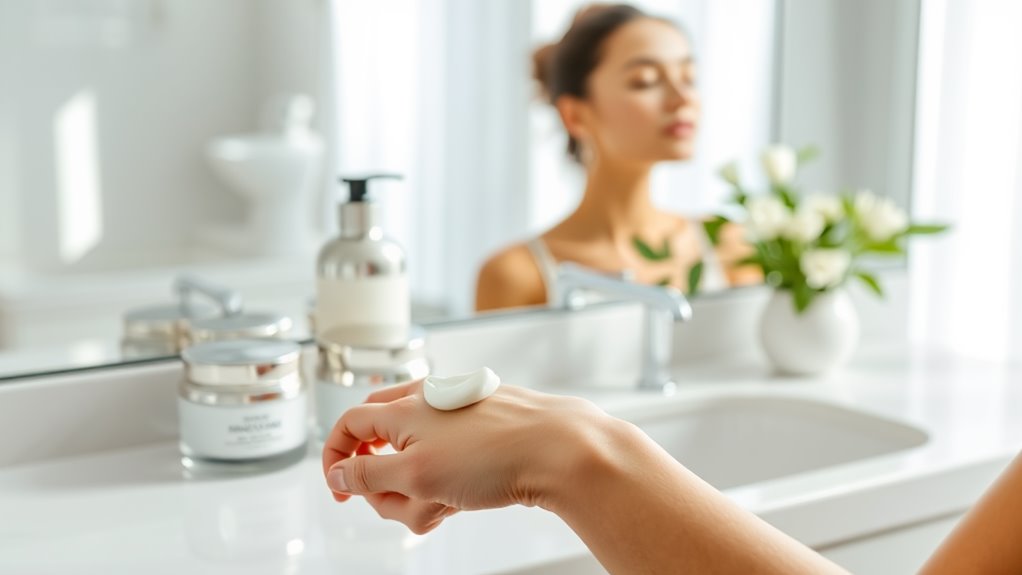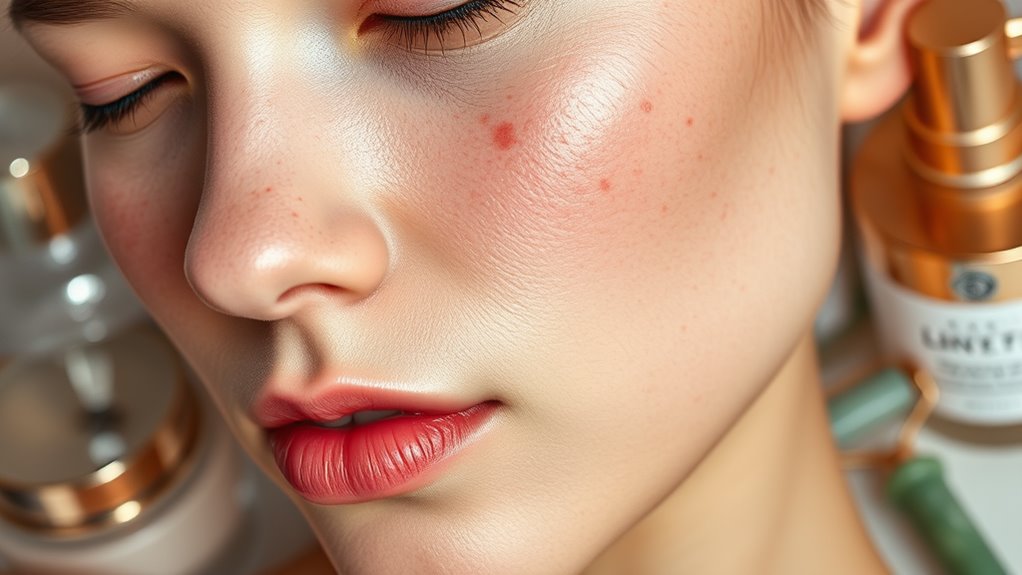Don’t Skip This Step If You Have Oily Skin
If you have oily skin, don’t skip cleansing. It’s essential to remove excess oil, dirt, and impurities without stripping moisture. Use a gentle, non-comedogenic cleanser containing salicylic acid or tea tree oil. Following up with the right toner can help balance oil production and minimize pores. Exfoliating regularly also prevents clogged pores by removing dead skin cells. Keep following these steps for optimal skin health, and discover more techniques that can further enhance your routine.
Key Takeaways
- Cleansing twice daily is essential to remove excess oil and impurities, promoting clearer skin and preventing breakouts.
- Use a toner with oil-controlling ingredients like witch hazel or salicylic acid to balance oil production and minimize pores.
- Regular exfoliation, two to three times a week, helps prevent clogged pores and improves skin texture.
- Lightweight, oil-free moisturizers are crucial for hydration, ensuring skin balance without adding excess oil.
- Always apply a broad-spectrum sunscreen with at least SPF 30 to protect against UV damage and prevent skin issues.
Understanding Oily Skin
Oily skin results from overactive sebaceous glands that produce excess sebum, a natural oil that can lead to a shiny complexion and clogged pores. This condition often stems from genetic factors, hormonal fluctuations, and environmental influences.
You might notice that oily skin is prone to acne breakouts, blackheads, and enlarged pores. To effectively manage this skin type, it’s essential to adopt an oily skin step that targets excess oil without stripping your skin of necessary moisture.
Understand that balancing sebum production is key; using lightweight, non-comedogenic products can help. Regular exfoliation can also prevent pore blockages, promoting a clearer complexion. Additionally, controlling excess grease is crucial for maintaining a balanced appearance throughout the day.
The Importance of Cleansing
Cleansing is a fundamental step in managing oily skin effectively. Regular cleansing removes excess sebum, dirt, and impurities that accumulate on your skin’s surface. If left untreated, these contaminants can clog pores, leading to breakouts and inflammation.
A well-formulated cleanser can help balance your skin’s oil production without stripping away essential moisture. It’s crucial to choose a cleanser containing ingredients like salicylic acid or tea tree oil, which target oiliness and prevent acne.
Aim to cleanse twice daily—once in the morning and once before bed—to maintain a clear complexion. By establishing a consistent cleansing routine, you not only improve your skin’s appearance but also enhance its overall health, promoting a balanced environment for optimal function. Additionally, avoiding cleansing mistakes is essential to protect your skin barrier and ensure effective cleansing results.
Choosing the Right Toner
When choosing a toner for oily skin, it’s essential to focus on key ingredients that help balance oil production and minimize pores.
Look for alcohol-free options or gentle astringents that won’t strip your skin of its natural moisture. Incorporating a toner with specific skin type targeting ingredients will enhance its effectiveness in your skincare routine.
Understanding these factors will guide you to select a toner that effectively supports your skincare routine.
Key Ingredients to Look For
Selecting the right toner for oily skin involves identifying key ingredients that effectively balance oil production and minimize breakouts. Focus on these essential components:
| Ingredient | Benefits |
|---|---|
| Salicylic Acid | Penetrates pores, reduces acne |
| Witch Hazel | Natural astringent, controls oil |
| Tea Tree Oil | Antimicrobial, combats bacteria |
| Niacinamide | Regulates sebum, improves texture |
| Glycolic Acid | Exfoliates, prevents clogged pores |
When you choose a toner rich in these ingredients, you help ensure your skin remains clear and balanced. This targeted approach can lead to a more refined complexion, instilling confidence as you master your skincare routine. Always remember to patch test new products to gauge your skin’s response.
Alcohol-Free vs. Astringents
While choosing the right toner for oily skin, you may find yourself deciding between alcohol-free options and traditional astringents.
Alcohol-free toners are often gentler, helping to maintain your skin’s moisture barrier while still providing essential benefits like pore tightening and oil control. Ingredients like witch hazel and tea tree oil can effectively reduce shine without causing irritation or dryness.
On the other hand, traditional astringents, typically containing higher alcohol content, may strip excess oil but can lead to over-drying and trigger rebound oiliness.
Therefore, if you want long-term balance and hydration, opt for alcohol-free toners. Ultimately, understanding your skin’s needs will guide you in selecting a toner that enhances your oily skin care routine without compromising its health.
Exfoliation Techniques for Oily Skin
Exfoliation is crucial for managing oily skin, as it helps remove dead skin cells and prevents clogged pores.
You can choose between chemical exfoliants, which offer deeper penetration, or physical methods that provide immediate texture improvement. Understanding the benefits of each type, along with the optimal frequency and timing for exfoliation, will enhance your skincare routine. Additionally, it’s important to remember that even oily skin needs adequate hydration to maintain its balance and health.
Chemical Exfoliants Benefits
When you incorporate chemical exfoliants into your skincare routine, you can effectively address the unique challenges of oily skin.
These products, typically containing alpha-hydroxy acids (AHAs) or beta-hydroxy acids (BHAs), penetrate the skin to dissolve excess sebum and remove dead skin cells. This process helps prevent clogged pores, reducing the risk of breakouts and improving overall texture.
Additionally, chemical exfoliants promote cellular turnover, allowing for fresher, more radiant skin. They also possess anti-inflammatory properties, which can calm irritation associated with oily skin.
Regular use can enhance the absorption of other skincare products, maximizing their efficacy.
Physical Exfoliation Methods
To effectively manage oily skin, incorporating physical exfoliation methods can be a game-changer.
These techniques remove dead skin cells and help unclog pores, reducing shine and preventing breakouts. Here are three effective methods you can use:
-
Exfoliating Scrubs: Look for scrubs containing natural exfoliants like walnut shells or sugar. Use them gently to avoid irritation.
-
Facial Brushes: Invest in a soft bristle or silicone facial brush. These tools provide a deeper clean while promoting circulation.
-
Microdermabrasion Tools: These devices use fine crystals to slough off the outer layer of skin. They can significantly improve texture and tone.
Incorporating these physical exfoliation methods into your routine will enhance your skin’s clarity and health.
Frequency and Timing Tips
Understanding the right frequency and timing for exfoliation is crucial for managing oily skin effectively. Aim to exfoliate two to three times a week, depending on your skin’s tolerance.
Over-exfoliating can strip your skin of natural oils, leading to increased oil production. Choose evenings for exfoliation, as this allows your skin to recover overnight.
Consider using chemical exfoliants like salicylic acid or glycolic acid for deeper penetration, especially if you experience breakouts. Always follow up with a lightweight, oil-free moisturizer to maintain hydration without clogging pores.
Monitor your skin’s response; if irritation occurs, reduce frequency. Ultimately, consistency is key to achieving and maintaining balanced, healthy skin. Adjust your routine as needed for optimal results.
Moisturizing Myths and Facts
Many people believe that moisturizing is unnecessary for oily skin, but this misconception can lead to imbalances in your skin’s health.
In reality, proper hydration is crucial, even for those with excess oil production. Here are three key points to understand:
-
Hydration Balance: Oily skin can still become dehydrated, which may trigger even more oil production as your skin compensates.
-
Choosing the Right Moisturizer: Opt for lightweight, non-comedogenic moisturizers that won’t clog pores, such as gel-based or oil-free formulas.
-
Prevention of Damage: Moisturizing helps maintain the skin barrier, protecting against environmental stressors and preventing premature aging. Additionally, using a suitable moisturizer can enhance your skin’s hydration levels, leading to a more balanced complexion.
Sun Protection Essentials
Protecting your skin from harmful UV rays is crucial, even if you have oily skin.
Choosing the right sunscreen formula and applying it correctly can help prevent breakouts while ensuring effective sun protection.
Let’s explore the key aspects of sunscreen that will keep your skin healthy and radiant.
Importance of Sunscreen
While you may focus on managing oily skin, neglecting sunscreen can undermine your efforts.
Sunscreen is essential for preventing skin damage, especially for oily skin types, which can be more prone to inflammation and breakouts. Here are three key reasons why you shouldn’t skip it:
-
Prevents UV Damage****: Ultraviolet rays can cause skin cancer and accelerate aging, making sunscreen a critical barrier.
-
Reduces Oiliness: Some formulations can help control excess oil, making your skin appear less shiny throughout the day.
-
Balances Skin Tone: Sunscreen protects against hyperpigmentation, ensuring a more even skin tone over time.
Incorporating sunscreen into your daily routine is fundamental to maintaining healthy, resilient skin.
Don’t overlook this crucial step!
Choosing the Right Formula
How can you find the right sunscreen for oily skin? Start by looking for non-comedogenic formulas that won’t clog your pores.
Opt for gel or water-based sunscreens, as they typically absorb quickly and leave a matte finish. Ingredients like zinc oxide or titanium dioxide provide broad-spectrum protection while being less likely to irritate sensitive skin.
Additionally, consider sunscreens containing salicylic acid or niacinamide, which can help control oil production and minimize breakouts. Always choose an SPF of at least 30 to ensure adequate protection.
Avoid heavy creams or oils, as these can exacerbate shine and lead to acne. By selecting the right formula, you can effectively shield your skin without compromising its health.
Application Tips for Oily Skin
Finding the right sunscreen formula is just the beginning; applying it correctly is equally important for effective sun protection, especially with oily skin.
Follow these tips to maximize your sun protection:
-
Apply Generously: Use about a nickel-sized amount for your face and ensure even coverage. Don’t skimp—adequate application is crucial for efficacy.
-
Layer Wisely: Allow your sunscreen to absorb for at least 15 minutes before applying makeup or other products. This prevents pilling and ensures optimal protection.
-
Reapply Regularly: Reapply every two hours, or more frequently if you’re sweating or swimming. Use a lightweight, oil-free spray or powder for convenient touch-ups throughout the day.
Mastering these application techniques will significantly enhance your skin’s defense against UV damage.
Selecting Suitable Makeup Products
Selecting suitable makeup products for oily skin is crucial to maintaining a balanced complexion and preventing excess shine.
Opt for oil-free or non-comedogenic foundations that won’t clog your pores. Look for matte finishes, as they help absorb excess oil and reduce shine throughout the day.
Additionally, consider using powder formulations for setting your makeup; these can effectively control sebum production. Ingredients like salicylic acid and kaolin clay are beneficial, as they help manage oil levels while providing coverage.
Avoid heavy creams and high-gloss products that can exacerbate oiliness.
Lastly, always test products patch-wise before full application to ensure compatibility with your skin.
Incorporating Clay Masks
When you incorporate clay masks into your skincare routine, you’re taking a proactive step toward managing oily skin and minimizing breakouts.
Clay masks work by absorbing excess oil, unclogging pores, and providing essential minerals that enhance skin health.
To maximize their benefits, follow these three guidelines:
-
Choose the Right Clay: Opt for bentonite or kaolin clay, known for their oil-absorbing properties.
-
Frequency of Use: Apply a clay mask 1-2 times a week to prevent over-drying while effectively controlling oil production.
-
Complement with Moisturizer: After using a clay mask, apply a lightweight, oil-free moisturizer to maintain hydration without adding excess oil.
Incorporating clay masks thoughtfully can significantly improve your skin’s balance and clarity.
The Role of Diet in Managing Oiliness
Managing oily skin isn’t just about topical treatments; your diet plays a significant role in oil production. Foods high in refined carbohydrates and sugars can trigger insulin spikes, leading to increased sebum production.
Instead, focus on incorporating omega-3 fatty acids found in fish, flaxseeds, and walnuts, which can reduce inflammation and balance oil levels. Additionally, antioxidants from fruits and vegetables help combat oxidative stress, further supporting skin health.
Staying hydrated is crucial, as water aids in maintaining skin moisture without excess oiliness. Limit dairy and fried foods, as they may exacerbate oiliness for some individuals.
Establishing a Consistent Skincare Routine
Establishing a consistent skincare routine is essential for effectively managing oily skin and achieving a balanced complexion.
Consistency ensures that your skin receives the necessary care and products to regulate oil production and prevent breakouts.
Follow these key steps:
-
Cleanse Twice Daily: Use a gentle foaming cleanser containing salicylic acid to remove excess oil without stripping your skin.
-
Exfoliate Regularly: Incorporate a chemical exfoliant containing alpha or beta hydroxy acids 2-3 times a week to unclog pores and reduce shine.
-
Moisturize: Opt for oil-free, non-comedogenic moisturizers to hydrate your skin while maintaining balance.




